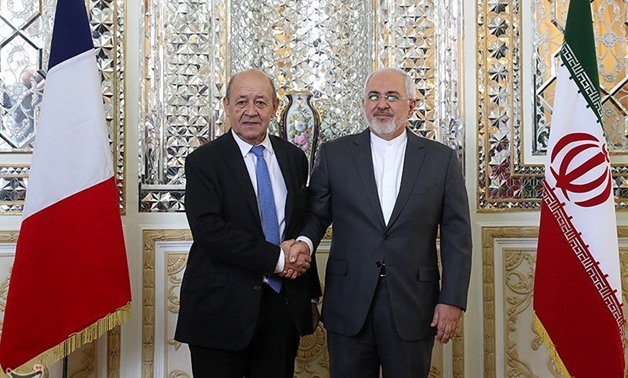
Iranian President Hassan Rouhani shakes hands with French Foreign Affairs Minister Jean-Yves Le Drian, in Tehran, Iran, March 5, 2018. President.ir/Handout via REUTERS
TEHRAN (Reuters) - After a day of tough talking in Tehran on Monday, France’s foreign minister and one of Iran’s vice presidents ambled through the halls of the National Museum of Iran to admire a collection of artworks on loan from the Louvre in Paris.
Relations between Iran and France have grown fraught of late, rattled by the uncertain future of the Iran nuclear accord and French concerns over Tehran’s ballistic missile tests and military activities in the Middle East.
But President Emmanuel Macron’s government hopes the soft power of cultural diplomacy can help strengthen bilateral ties.
“In the turbulent ocean of international diplomacy, cultural diplomacy is a beacon we must keep alight,” French Foreign Minister Yves Le Drian told a large audience at an event sponsored by French oil giant Total.
A French diplomat was more blunt: “Whatever disagreements we may have with Iran we want to keep and develop a cultural relationship with Iranian society.”
The Louvre exhibition in Tehran is the first by a major Western cultural institution and was agreed upon during a visit to Paris by Iranian President Hassan Rouhani in 2016, when Francois Hollande was France’s leader.
In a statement, the Louvre said its international strategy was directly influenced by French diplomatic priorities.
The four-month exhibition will display some 50 works from the Louvre, including a sphinx statue and other artifacts linked to Greek, Egyptian and Mesopotamian culture, as well as objects from ancient Iran.
France has historically had a less fractious relationship with Iran than either Britain or the United States. While Britain explored for Iranian oil in the 20th century, France undertook archaeological digs.
“I think our archaeological past in Iran has at least left a positive imprint,” the French diplomat said.
In an ironic twist, the Louvre in late 2017 opened its first overseas branch in Abu Dhabi, capital of the United Arab Emirates which accuses Iran of destabilizing the Middle East and has broken off diplomatic relations.
The future of Iran’s nuclear deal with world powers is shrouded in doubt after U.S. President Donald Trump pronounced it “flawed” and gave Europeans until May 12 to fix it.
Le Drian on Monday delivered a message to Tehran that Europe wanted to keep alive the accord that eased economic sanctions in return for curbs to its nuclear program, while echoing U.S. concerns about Iran’s missile program and role in regional wars.
The brick building of the National Museum of Iran, which opened in 1937, was designed by two French architects influenced by Iran’s Sassanian heritage.

Comments
Leave a Comment